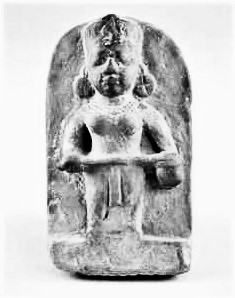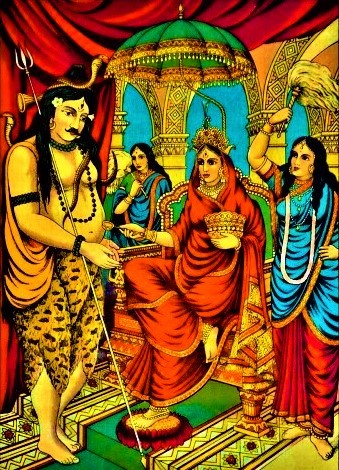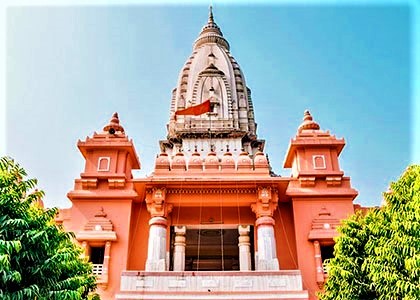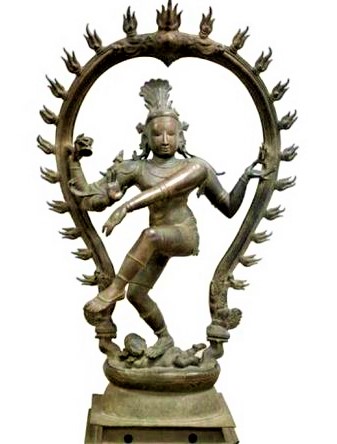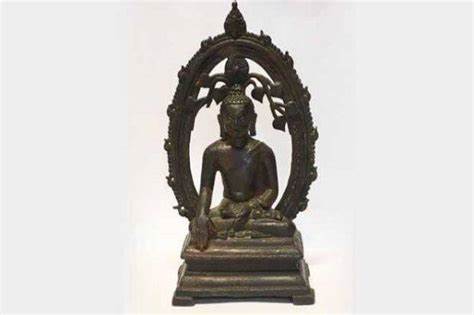Imperial, Colonial Thieves: The Long Odysseys of Goddess Annapurna and Treasures of India (Part 2)
TRANSCEND MEMBERS, 7 Mar 2022
Prof Hoosen Vawda – TRANSCEND Media Service
The Ungodly Thievery of Godly Treasures from India
It is summer of 1931, the day was hot and humid, when Mr Norman MacKenzie[1], a Canadian lawyer, a collector and patron of the arts, from Saskatchewan, visited India. This was during the glorious period of British Raj[2] in India when the local “heathen, coolies”[3] were of no significance to the White, British imperialist. MacKenzie was keen to travel to The Annapurna Devi Temple[4], built centuries ago, on the western banks of the Ganges River[5].[6] in the Hindu, holy city of Banaras[7], also called Varanasi, which is the revived name, after independence of India on 15th August 1947[8]. The city is also named Kashi[9], (The Light) by the millions of Hindu pilgrims who visit the spiritual city annually, for a ceremonial purification in the holy waters of the Ganga River[10], which again has important religious significance for all Hindus. Norman arrived in the holy city and was being taken on a tour of the temple, by the guide, who explained the history of the temple and the significance of the statues placed therein. Barrister MacKenzie appreciatively commented to the guide that he especially loved the idol of the Annapurna Devi, amongst others. Reportedly, this conversation was overheard by a miscreant inside the temple and that evening, Mr Norman Mackenzie, the White foreigner, was presented with the Annapurna Murthie wrapped in newspaper by the individual who overheard the conversation, in the temple, earlier that day. He examined the 18th century idol, measuring 17x9x4 cm, carefully, as an antiquities art connoisseur, and realised that he was holding and has acquired the priceless “Queen of Varanasi”. Mackenzie knew the importance and significant of the murthie[11], also spelt murti, which depicted Goddess Annapurna carrying a bowl of kheer[12] or rice pudding, served as a dessert in South Asian religious festivals, in one hand and a spoon in the other. In the classical Indo-Aryan Sanskrit[13] language, the word “Anna” means food or grains and ‘Purna’ means full or complete. He kissed the idol, gave the miscreant an undisclosed amount of valuable British sterling[14], carefully wrapped the tablet amongst his clothing and placed it in his suitcase. He then left India expediently, delighted with his newly acquired, stolen loot, to return to Canada. Being a White foreigner, the Indian customs did not check his baggage and in the absence of any x-ray security at the exit port in Bombay, at the time, he boarded the ship with the murthie safely in his luggage to return to his home country after his 1913 trip to India, Again, the Canadian immigration passport control did not pay particular attention to the small idol carved in the stone tablet, in Mackenzie’s luggage, even if they checked his baggage, as he was a well-known art collector and a respected lawyer, in Canada, a British colony, only becoming a truly independent country, only in 1982, by the proclamation of Her Majesty, the Queen of England.[15]
Hence, effectively, an extremely important piece of a Hindu religious artefact, at the time, housed at a dedicated temple in Varanasi, was stolen and taken away to a foreign land, by a Britisher, to the deprivation of the indigenous people of India, to whom the little idol was of a great religious and cultural significance. The Hindus, to whom, for centuries had sincerely prayed for their food security. This piece of ancestral and religious history was deceptively stolen from their midst, from a special temple, to remain in Canada for over 108 long years. Nobody in Varanasi, including the temple authorities, questioned the disappearance, nor the whereabouts of the idol, which mysteriously vanished, overnight, while India was under the control of the oppressive and exploitative British Raj, in 1913.[16]
Annapurna idol carries a huge significance for Hindus, particularly those in Varanasi. She is worshipped not only as the goddess of food and nourishment, but also as a manifestation of Goddess Parvati[17], the consort of Lord Shiva[18], one of the three deities of the Hindu holy trinity[19], and is thus called the ‘Queen of Varanasi’, since the city is said to be Lord Shiva’s home. The goddess has a temple dedicated to her in Varanasi, the Annapurna Devi Mandir. which itself has a long, sad history, under the different occupations and regimes in India.
Annapurna Devi Mandir, also known as Annapurna Mata Mandir [20]and Annapurna Mandir, is one of the most famous Hindu temples in the holy city of Varanasi. Annapurna Devi Mandir is situated in Visheshwarganj[21], Varanasi. It is situated 15 meters North-West of the famous Kashi Vishwanath Mandir[22] which is dedicated to Lord Shiva[23] in Hinduism, 350 meters West of Manikarnika Ghat[24], the holiest, Hindu cremation area, 5 kilometers South-East of Varanasi Junction railway station and 4.5 kilometers North-East of Banaras Hindu University. This temple has great religious importance in Hinduism and is dedicated to the goddess Annapurna. Annapurna is the Hindu goddess for nourishment and is a form of the goddess Parvati. The current Annapurna Mandir was constructed in 1729 by Maratha Peshwa Bajirao.[25] The temple is constructed in Nagara architecture[26] and has sanctum sanctorum[27], with large pillared porch, which houses a picture of goddess Annapurna. The temple also houses two icons of the goddess; one made of gold and other of brass. The brass icon is available for daily darshan or viewing and worship. The gold icon can be only seen once a year; on Annakut day.[28] In Hindu mythology, there are two popular beliefs behind the origin of this temple. According to one belief, once the goddess Parvati closed all three eyes, Sun, Moon and Fire, of her husband, Lord Shiva. Due to this, the entire world was plunged into darkness. Parvati’s fair complexion, the Gauri form, became darkened. She then begged Lord Shiva for his help to reacquire her Gauri (fair) form and her fair complexion. To remedy the situation, Lord Shiva asked her to donate anna (food) in Varanasi. Hence, she took the form of Annapurna, the Goddess of food, with a golden pot and ladle, donated food in Varanasi.
According to a second narration, once Shiva commented that the entire world, including food, is maya or an illusion. Parvati, the Goddess of Food, became extremely angry and decided to demonstrate the importance of food by making all the food, as well as herself, on earth disappear. The world started to suffer due to hunger. Even the Gods experienced famine to such an extent, that Lord Shiva finally came to Parvati, unaware who she was in the Annapurna avatar[29] and acknowledged the importance of food, begging for food at her door. Parvati became happy, offered food with her own hands to Shiva and then made a kitchen in Varanasi for her devotees.[30]
The murthie remained in the private collection of Norman Mackenzie. The son of an Ontario judge, Norman Mackenzie was born in Sarnia, Ontario[31], in 1869, and moved west to Regina[32] in 1891. He became a well-known lawyer, an active member of the Regina community, and an avid art collector. He began collecting art in 1900 and the collection grew to include works he gathered during the annual trips that he took to Europe until 1914, works from the Far and Near East, and works by local western Canadian artists, such as Henderson [33]and Sheldon-Williams[34]. At his death in 1936, MacKenzie’s art collection later partnered with the University of Regina[35], Canada, and, in 1953, established the Norman MacKenzie Art Gallery to exhibit works from his collection,[36] including the Annapurna Murthie stolen from India, in 1913.
It is interesting to note how the Annapurna idol was rightfully repatriated from Regina in the province of Saskatchewan, Canada, where the author has visited the collection, there in 1991, to India after 108 long years. Through serendipity or divine providence, call it what you will, Annapurna developed a longing to return to her home, as the Queen of Varanasi from forced exile and retake her rightful place next to her husband, Lord Shiva, in Varanasi. Instrumental in this repatriation programme was Ms Divya Mehra[37], a Winnipeg[38], based artist, with an Indian genealogy, while studying MacKenzie’s collection during the preparation for her exhibition ‘From India to Canada and Back to India’, brought attention to the fact that the statue had been stolen from India over a century ago. During her research, she found that “a stranger had overheard MacKenzie’s desire to have the statue, and stole it for him from its original location, a shrine on the stone steps. on the riverbank of the Ganga at Varanasi, India”, the university website stated.
Divya Mehra is a Canadian artist from Winnipeg, Manitoba.[39] Known for her meticulous attention to the interaction of form, medium and site, Mehra’s work deals with her diasporic experiences and historical narratives. She incorporates found artifacts and readymade objects as active signifiers of resistance or as reminders of the difficult realities of displacement, loss, neutrality and oppression. Dr Siddhartha V. Shah, curator [40]of Indian and South Asian Art at the Peabody Essex Museum[41], identified the statue as the Hindu goddess Annapurna. The University of Regina readily agreed to return the statue, however, the return delayed due to the pandemic. The virtual repatriation ceremony was held on 19th November 2020, with the university officially handing over the statue to Ajay Bisaria, India’s High Commissioner [42]to Canada. However, the idol was only received by the Archaeological Survey of India [43](ASI) on 15th October 2021 after the long delay due to the pandemic.
The Union Ministry of Culture [44]formally handed over the idol to the Uttar Pradesh [45]government at a ceremony held at New Delhi’s National Gallery of Modern Art [46]in a ceremony attended by Uttar Pradesh Chief Minister Yogi Adityanath[47]. Idols of five other deities removed during the reconstruction of the temple were also installed. The idol of the goddess was taken to the temple in a silver palanquin[48], shouldered by Chief Minister Adityanath. The procession started from the Kushmanda Temple in Durgakund[49] in the morning. It was installed in the north-east corner of the temple amid chanting of hymns.
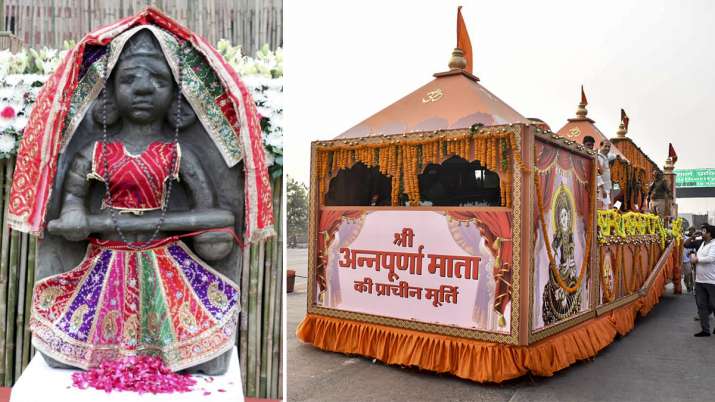
The Reinstallation of the Annapurna Devi Statue in a Mega procession in Varanasi. Note the Goddess colourfully attired in a traditional costume for the occasion
The Chief Minister had arrived here on a two-day visit on. He inspected the cleaning and repair of the Shahi drain on the Lahurabir-Maidagin [50]road, late in the night and ordered to complete the work on a war footing.[51] Adityanath also took stock of the construction of the Kashi Vishwanath temple corridor after paying obeisance at the temple. The idol of the goddess Annapurna was installed at the Kashi Vishwanath Temple in Varanasi on 15th November 2021 by Uttar Pradesh Chief Minister Yogi Adityanath, more than 100 years after it had been stolen from the Annapurna Mandir along the western river bank of the holy Ganges River. Like many other statues of the Goddess found presently, the statue now installed at the Kashi Vishwanath Temple also depicts the goddess wearing large round earrings and a necklace.
The magnitude of the theft of religious artefacts over the centuries, from India is reflected in the formal return of a total of 36 antique idols and artefacts returned to India by the United States, Australia, as well as the United Kingdom, where such national treasures were also the subject of a legal case against the British government, in which the court ruled in favour of India and the British were compelled to return the artefacts to India, over the past five years.[52]
Recently, in Kallidaikurichi which is a town on the right bank of the Thamiraparani River in Ambasamudram Taluk of Tirunelveli district in Tamil Nadu, a southern state of India[53], it was a day of great celebration for residents of the town, as they witnessed the return of a Nataraja idol[54], worth Rs 30 crore, (3, 924 000 US Dollars). stolen from their town 37 years ago. Thousands gathered to witness the return of the idol which was paraded across the town by priests. The idol which was at the Art Gallery of South Australia for 19 years[55], was handed over to the Idol Wing of the State Police of India.[56]
The Nataraja idol was stolen in 1982 from the Sri Kulasekaramudaiyar Temple [57]along with statues of Goddess Sivagami[58], Manickavasagar[59] and Sribalinayakar[60]. Internal corruption was suspected and the case had been closed by the local police two years later, claiming they could not trace the stolen idols. In 2017, it was reopened by the Idol Wing who traced it to an Art Gallery in Adelaide, Australia. The two and a half feet idol which was displaced in the museum gallery in Adelaide, Australia for 17 years. As a result of the Idol Wing special officer and retired Inspector-General of Police A.G. Ponn Manickavel’s [61]persistent effort to bring the Indian heritage back to the country, the Australian authorities formally handed over the idol to officers of the wing in New Delhi. The idol was brought by Manickavel and his team from New Delhi by train and will reach Chennai in Tamil Nadu. Manickavel revealed that after locating and convincing the Australian authorities and Art Gallery of South Australia (AGSA) by producing the records substantiating that the temple is the original owner of the idol with photographs taken before the theft of the idol, that the idol belonged to India, they agreed to return the idol. However, strangely, the Tamil Nadu State [62]government refused funds to bring back the idol.
“The Tamil Nadu government had been dodging for 330 days to bear the cost of bringing back the idol to the State by air. The registrar of Art Gallery of South Australia (AGSA), Jane Robinson[63], at the request of the special investigation team, spent their own money to bring back the idol and handed it over to us,” he added. The idol was handed to the temple authorities after the necessary formalities were done and orders were obtained from the special court for Idol Wing cases at Kumbakonam[64]. According to sources, the idol, weighing around 100 kg, was stolen after the doors of the sanctum sanctorum were broken open on 05th July 1982. Along with it, a 2.5-foot tall panchaloka idol of Sivagami, 1.5-foot tall Manickavasagar idol and 1-foot tall Sribali idol were also stolen. A complaint was filed by the then trustee of the temple, following which the Kallidaikurichi[65] police had registered a First Information Report (FIR) on July 6, 1982. However, two years later the Kallidaikurichi police closed the case concluding that the idol was untraceable.
However, a few years ago, the case was handed over to the court-appointed Idol Wing special team, led by Manickavel. After investigation, the case was reopened and taken up for investigation by the Idol Wing’s SP Rajaram.[66] Recently, Tamil Nadu police’s Idol Wing led by A.G. Ponn Manickavel apprehended a gang which had been illegally exporting stolen antiques, idols and artefacts worth crores for several years from Puducherry[67] to France through the Colombo port and recovered the artefacts.
The Tamil Nadu government were in talks with the National Gallery of Australia to get back seven, other stolen ancient idols. The state government has claimed a 1,300-year-old standing Sambandar bronze idol[68], another rare bronze, a 1000-year-old dancing Sambandar, stolen from the Naganathaswamy Temple at Manambadi [69]village in the Tiruvidaimaruthur taluk of Nagapattinam district[70] which was sold for Rs 4.59 crores.
The state has claimed many idols, a 1000-year-old of Arumugan from Manambadi[71], and a 1100-year-old Nandi idol, Bhadrakali idol of the Kailasanathar temple at Kollumangudi, in Mayiladudurai taluk, and two stone Dwarapalakar idols from Udayar Sivan temple in Atthanallur, Tirunelveli[72]. These idols were smuggled out of the country by various antique dealers at different points in time. Ponn Manickavel, after taking charge, reopened investigations and booked the new cases.
Recently, two 1000-year-old bronze idols of Rajaraja Chola and his wife, Lokamadevi, were returned to Tamil Nadu after they were stolen from Brihadeeshwarar temple at Thanjavur over 50 years ago. Three years ago, Australia had returned three artefacts, including an idol of goddess Pratyangira, stolen from a Shiva temple in Cuddalore district in Tamil Nadu. In 2014, then Australian Prime Minister Tony Abbott had returned two statues of Nataraja and Ardhanariswarar stolen from temples in the state.[73]
About 1200 ancient idols are believed to have been stolen from Tamil Nadu between 1992 and 2017 out of which 350 have been declared untraceable and only 18 had been retrieved until last year. Owing to the lax behaviour of the authorities the Tamil Nadu government had last year at the beginning of August informed the Madras High Court that it had decided to transfer all the idol theft cases to the CBI.[74]
Noting that there is a lucrative market in artefacts from antiquity, thieves stole a black Buddha statue with silver inlays[76] which lay in the open from the village of Nalanda[77] However, London police returns stolen Buddha statue to India on Independence Day. The bronze statue with silver inlay is one of the 14 statues stolen in 1961 from the ASI site museum in Nalanda. The statue had changed several owners, over the years, before surfacing at a London auction.[78]Apart from religious artefacts, numerous gemstones were also hoarded off by foreign powers, over the centuries. When referring to gemstones, the Koh-I-Noor is the key diamond ‘stolen” by Britain.[79] The author describes this stone in Part 1 of this publication[80]. However, there are other legendary jewels of India which have been taken by various irregular means, gracing different crowns and museums across the world. Not just Koh-I-Noor, but numerous precious jewels of India were found in the enormous alluvial deposits of Andhra Pradesh and Telangana,[81] and today, they adorn crowns and museums all over the world. Indian royalty has always been synonymous with exquisite jewels. It is not new that the jewels of India have played a significant role in Indian history. India’s jewellery is a striking reflection of the country’s aesthetic and cultural history, with a more than 5,000-year legacy. They are beautiful, natural, and have the iridescence of a star.
One such gemstone is the Hope Diamond [82]which is a 45.52 carat diamond which was extracted from the Kollur Mine in Guntur, India, in the 17th century. Due to the trace amounts of boron, it has a blue colour. The stone is known as a Golconda Diamond[83]. The Tavernier Blue diamond was purchased by French gem merchant Jean-Baptiste Tavernier in 1666, according to the earliest records. Tavernier sold the stone to King Louis XIV of France in 1668 after it was cut and called the French Blue (Le bleu de France). It was lost in 1791 and re-cut, with the largest section of the diamond appearing in an 1839 gem catalogue from the Hope banking family under the Hope name. The diamond has had many renowned owners, including Washington socialite Evalyn Walsh McLean, who was frequently seen wearing it. Harry Winston, a New York gem merchant, purchased the diamond in 1949 and toured it for several years before donating it to the National Museum of Natural History [84]in the United States in 1958, where it is on permanent exhibition.
The Daria-i-Noor [85]is one of the world’s largest cut diamonds, weighing an estimated 182 carats. Its pale pink colour is one of the rarest in diamonds. This Indian diamond was discovered in the Kollur mine in the Indian state of Andhra Pradesh. It was one of the jewels of India and was originally owned by the Kakatiya dynasty and later by the Delhi Sultanate’s Khalji dynasty and Mughal emperors. It was part of the Peacock Throne of Shah Jahan.
Nader Shah of Iran invaded Northern India and occupied Delhi in 1739. In exchange for returning the crown of India to the Mughal emperor, Muhammad, he took possession of the Mughals’ entire fabled treasury, including the Daria-i-Noor, as well as the Koh-i-Noor and the Peacock Throne. Sharukh Mirza, Nader Shah’s grandson, inherited the diamond after his father died in 1747. It then fell into the hands of Lotf Ali Khan. Following Lotf Ali Khan’s defeat at the hands of Mohammad Khan Qajar, who established Iran’s ruling Qajar dynasty, the Daria-i-Noor was transferred to the Qajar treasury. The diamond is currently housed in the Iranian Crown Jewels collection at the Central Bank of Iran in Tehran.
The Noor-ul-Ain[86], the tiara’s centrepiece, is one of the world’s largest pink diamonds. The diamond is believed to have been recovered from the Golconda mines in Hyderabad, India. It is one of the jewels of India and the first in possession of the nizam Abul Hasan Qutb Shah. The jewel was later given as a peace offering to the Mughal emperor Aurangazeb after he defeated him in a siege. In the 18th century, it was also added into the Iranian Imperial collection by Persian king Nader Shah Afshar. The Noor-ul-Ain is believed to have been part of a much larger gem known as the Great Table diamond. The larger diamond is thought to have been cut in two, with one section becoming the Noor-ul-Ain diamond and the other becoming the Daria-i-Noor diamond. Both of these pieces are currently housed in the Iranian Crown Jewels.
The Hortensia diamond[87], one of the Golconda Diamonds, was mined in India and is now part of the French Crown Jewels. It’s a 20-carat pale orange-pink diamond cut into a five-sided shape with a “feather”, which is a fine visible crac, running from tip to girdle. The Hortensia was purchased by King Louis XIV of France in 1643 and remained in his possession until 1715. During the French Revolution, it was stolen in 1792 from the Garde-Meuble de la Couronne in Paris, presently the Hôtel de la Marine. It was discovered in an attic in Paris’s Les Halles district. It was stolen again in 1830. This time from the Ministry of the Navy, but recovered shortly after. The Hortensia is on display at the Galerie d’Apollon of the Louvre museum in Paris.
The Regent diamond[88], also known as the Pitt diamond, was a brilliant-cut stone with a slight blue tinge that was once the crown jewel of France. The diamond was discovered by a man in the Kollur Mine in India in 1701 and weighed 410 carats in rough form. Sir Thomas Pitt, the British governor in Madras, purchased it and published a letter in the London Daily Post to dispel rumours that he had stolen the gem. The stone was cut to a 141-carat cushion brilliant called the Pitt diamond and purchased in 1717 by the Duke of Orléans, Regent of France, hence its present name. It was stolen, along with other crown jewels in 1792, but was recovered. Napoleon wore the stone in the pommel of his sword. It has been on display in the Louvre since 1887.
The long and scandalous saga of the Sancy diamond [89]is reminiscent of a thriller film. It can be traced back to Charles the Bold and France’s Louis XVI, and it has been pawned to finance wars, stolen several times, vanished and miraculously reappeared years later, and a loyal servant swallowed the stone rather than forfeit it to thieves. It was eventually removed from his cadaver. The Sancy is one of a few famous diamonds whose legendary histories hardly seem plausible, yet these stories have been passed down and documented for centuries. The Sancy, a 55.2-carat pale yellow pear-shaped diamond about the size of a strawberry, has been tracked for more than 500 years. It is now safely enclosed in the Louvre Museum in Paris.
The Shah Diamond, also known as Akbar Shah Diamond[90], was discovered in 1450 at the Golconda mines, presently in Andhra Pradesh, South India. This diamond is not of the first water, as it has a yellowish tinge due to iron oxide at the surface. It is said to have weighed 95 carats before being cut, and it lost 9 carats after. It currently weighs 88.7 carats. It is an elongated octahedron with fifteen facets replacing the eight original faces. It is frequently described as having the shape of a coffin. The diamond first belonged to Akbar the Great, the third Mughal Emperor who reigned from 1556 to 1605, one of India’s greatest emperors and the architect of the modern secular state. After Akbar Shah’s death, it was passed on to his successor, Emperor Jahangir Shah, who had it inscribed for the first time in 1619 A.D. Several inscriptions were made on the diamond. The diamond remained in the dynasty’s treasury until 1739, and later it disappeared for over a century. The diamond was later discovered and purchased by an English merchant named George Blogg, who re-cut it into a 73.60ct pear-shaped diamond. It is currently held in the Diamond Fund collection of the Kremlin Armoury in Moscow.
The Orlov Diamond[91], also known as Orloff Diamond, weighs in at a massive 300 carats and is a stunning, rare bluey, greenish coloured diamond. Its cut is an old-fashioned Mughal-cut rose with flawless clarity. The diamond’s shape has been described as half a pigeon’s egg, with rows of triangular facets on the upper surface and corresponding four-sided facets on the lower surface. The diamond has 180 facets in total. This diamond was said to have been discovered in India and was originally set as the diamond eye of a statue of Hindu God Vishnu[92], in the innermost sanctuary temple in Srirangam[93]. The diamond was later reported missing. After that, the stone was sold to an English sea captain. The diamond then made its way to Amsterdam, where the Russian Count Grigori Orloff, [94]purchased it and brought it back to Russia for his “wife”, Empress Catherine the Great[95]. The stone was placed in the Imperial Scepter, after Catherine received it.
When Napoleon Bonaparte[96] and his great army were about to enter Moscow in 1812[97], the Orloff was hidden in a priest’s tomb. Napoleon somehow discovered the diamond’s location. He was about to claim it as his own, when the priest appeared and cast a curse on the army. Napoleon and his army scampered away without the Orloff Diamond. The Orlov Diamond is still mounted in the Imperial Scepter [98]presently and is one of the most important items in the greatest collections of gems and jewelry, including the remaining Faberge Eggs [99]from the era of Tsar Nicholas11[100], who was executed, together with his entire family by the Bolsheviks[101], in 1917 during the Russian Revolution[102].
The Bottom Line is that while stolen or misappropriated religious and cultural artefacts from colonies, including India, previously occupied and plundered by Britain and European countries are gradually being returned to their rightful owners. It is however, important to note that priceless gemstones and associated artefacts are not returned, nor is any willingness to do so, especially by the government of Britain. This “”return our artefacts” campaign is being principally waged by personal investigators, individually, as well as a cohort of dedicated people globally, to ensure that the wrongs, which done during colonisation of indigenous peoples are rectified, even if this is effected after a period of 108 years. Organisations such as India Pride Project [103](IPP) which is a group of art enthusiasts who uses social media to identify stolen religious artefacts from Indian temples and secure their return. Co-founded in 2014 by two Singapore-based art enthusiasts, S. Vijay Kumar [104]and Anuraag Saxena[105], it now has activists from all over the world, who are most vigilant in their quest, creating great anxiety amongst colonial museums, reputable auctioneers and nervous private collectors, globally.[106] However, the recent discoveries and literally unearthing of ancient artefacts, in strange places and museums, in the western world, is just the tip of the proverbial iceberg. Much still needs to be done to continue this crusade of recovery, for an enormous cache of invaluable artefacts are secretly housed in private collections, which nobody wants to talk about. This category of theft, which was initially committed by colonialists, has now being syndicated to include governments, corrupt law enforcement agencies, organised crime, religious leaders, politicians, community support staff and includes the common, menial, labourers at the bottom of the ladder.
South Africa, which was previously pillaged of its resources by Dutch and British colonisers, up to the 20th century, as well as, recently by mega corporations, most of whom have joined the massive exodus from the country, recently, post 1994, where there are not many important artefacts, from antiquity, worth stealing, in South Africa, some of the ruling party government ministers, parliamentarians and officials, are focused on stealing millions of Rands, in public finds, as exposed by the phased release of the three massive volumes of “The Zondo Commission Reports”.[107] However, following the exposure of key government figures, involved in rampant corruption, the nation of thieves with 2.2 billion Rands looted to the deprivation of the masses of poor, disempowered South African, “with the most unscrupulous enablers in official positions, all too ready to feast on the relief meant for the most vulnerable in our society” [108] who are now heading to the courts for a judicial review to contest the legality and validity of the tomes of the reports, highlighting corruption in the highest offices of the land. Furthermore, such syndicates are also concentrating on rhino horns as a valuable commodity, leading to the extinction of the endangered animal species and diversifying into human trafficking and prostitution. It is interesting to note that the criminals in the streets in Southern Africa are quite happy to empower themselves with brutal carjacking, theft, with aggravating circumstances, including murder, “farm murders” domestic violence, including gender-based violence and mega armed robberies of large supermarkets, jewelry stores and cash in transit heists, committed brazenly, often with the police as accomplices.
References:
[1] https://www.bing.com/images/search?q=mr+norman+mackenzie+art+patron&qpvt=Mr+Norman+MacKenzie+art+patron&FORM=IGRE
[2] https://www.britannica.com/event/British-raj#:~:text=%20British%20raj%2C%20period%20of%20direct%20British%20rule,to%20reconsider%20the%20structure%20of%20governance%20in%20India.
[3] https://en.wikipedia.org/wiki/Coolie#:~:text=In%201727%2C%20Engelbert%20K%C3%A4mpfer%20described%20%22coolies%22%20as%20dock,with%20the%20exception%20of%20the%20North%20Dravidian%20branch.
[4] https://en.wikipedia.org/wiki/Annapurna_Devi_Mandir
[5] https://www.ganges-river.org/2017/04/05/places-on-the-bank-of-the-ganges/
[6] https://en.wikipedia.org/wiki/Ganges
[7] https://www.bing.com/travel/place-information?q=Varanasi&SID=f40e9476-1eeb-26ba-d77a-169d9e930e73&form=PLACAB
[8] https://en.wikipedia.org/wiki/Independence_Day_(India)
[9] https://www.yogapedia.com/definition/9089/kashi#:~:text=Kashi%20is%20the%20spiritual%20name%20of%20the%20northern,still%20called%20that%20today%20by%20the%20Hindu%20pilgrims.
[10] https://www.learnreligions.com/ganga-goddess-of-the-holy-river-1770295
[11] https://en.wikipedia.org/wiki/Murti
[12] https://en.wikipedia.org/wiki/Kheer
[13] https://en.wikipedia.org/wiki/Sanskrit
[14] https://en.wikipedia.org/wiki/Pound_sterling
[15] https://www.sidmartinbio.org/when-did-canada-gain-independence-from-the-british/
[16] https://icytales.com/british-oppression-in-india/#:~:text=The%20British%20oppression%20in%20India%20extended%20to%20its,Raj%20undermined%20the%20authority%20of%20the%20tribal%20leaders.
[17] https://vedicfeed.com/goddess-parvati-facts/
[18] https://en.wikipedia.org/wiki/Shiva
[19] https://slife.org/hindu-trinity/#:~:text=The%20Hindu%20trinity%20consists%20of%20three%20gods%20%E2%80%94,was%20creation%20of%20the%20world%20and%20all%20creatures.
[20] https://en.wikipedia.org/wiki/Annapurna_Devi_Mandir
[21] https://www.bing.com/maps?&ty=18&q=Visheshwarganj%2C%20Varanasi%2C%20Uttar%20Pradesh%2C%20India&vdpid=6958717934768226324&mb=25.319902~83.012749~25.317167~83.017799&ppois=25.31853485107422_83.01527404785156_Visheshwarganj%2C%20Varanasi%2C%20Uttar%20Pradesh%2C%20India_~&cp=25.318535~83.015274&v=2&sV=1&FORM=MIRE&qpvt=Visheshwarganj
[22] http://shrikashivishwanath.org/
[23] https://en.wikipedia.org/wiki/Hinduism
[24] https://en.wikipedia.org/wiki/Manikarnika_Ghat
[25] http://www.varanasi.org.in/annapurna-temple-varanasi
[26] https://www.bing.com/search?q=hindu+temple+architecture&filters=dtbk:%22MCFvdmVydmlldyFvdmVydmlldyFiNGQ1MThlZS03YjJjLTI2YmQtMTdmMC00ZmQ1NTIwMjA3Mjc%3d%22+sid:%22b4d518ee-7b2c-26bd-17f0-4fd552020727%22+tphint:%22f%22&FORM=DEPNAV
[27] https://en.wikipedia.org/wiki/Sanctum_Sanctorum#:~:text=The%20Latin%20phrase%20sanctum%20sanctorum%20is%20a%20translation,to%20imitations%20of%20the%20Tabernacle%20in%20church%20architecture.
[28] https://web.archive.org/web/20150406041844/http://www.templetravel.net/2013/04/annapurna-temple-in-varanasi-uttar.html
[29] https://www.bing.com/images/search?q=annapurna+avatar&qpvt=Annapurna+avatar&tsc=ImageHoverTitle&FORM=IGRE
[30] https://en.wikipedia.org/wiki/Annapurna_Devi_Mandir#Legend
[31] https://www.bing.com/search?q=sarnia&filters=dtbk:%22MCFvdmVydmlldyFvdmVydmlldyEwNWRlOTFmZi1lYjc4LWZmZWEtZGMzMS04NTliNjQ3NDAzYWY%3d%22+sid:%2205de91ff-eb78-ffea-dc31-859b647403af%22+tphint:%22f%22&FORM=DEPNAV
[32] https://www.bing.com/search?q=regina+canada&filters=dtbk:%22MCFvdmVydmlldyFvdmVydmlldyEwOTM3ZGUxZS1jYTc1LTE5ODktYWU2My02Zjc1NGMxZTg0YTQ%3d%22+sid:%220937de1e-ca75-1989-ae63-6f754c1e84a4%22+tphint:%22f%22&FORM=DEPNAV
[33] https://www.langmann.com/artists/james-henderson
[34] https://www.bing.com/images/search?q=sheldon+williams+canadian+artist&qpvt=sheldon+williams+canadian+artist&FORM=IGRE
[36] http://digital.scaa.sk.ca/scaa/gallery/art/galleries-mackenzie.html#:~:text=The%20son%20of,would%20be%20established.
[37] https://www.divyamehra.com/
[38] https://www.bing.com/search?q=winnipeg+canada&filters=dtbk:%22MCFvdmVydmlldyFvdmVydmlldyFjNmQ4MzkwNi02NTAyLTkxYzAtMWQ2Mi01ZGJkNzY3YTRiYmY%3d%22+sid:%22c6d83906-6502-91c0-1d62-5dbd767a4bbf%22+tphint:%22f%22&FORM=DEPNAV
[39] https://en.wikipedia.org/wiki/Divya_Mehra#:~:text=Mackenzie%2C%20Lindsay.%20%22%22Oh%20My%20Gosh!%20That%20Would%20Be%20Bananas%3B%20%2D%205%20Questions%20for%20Winipeg%20Artist%20Divya%20Mehra%22%22
[40] https://jnaf.org/artist/dr-siddhartha-v-shah/
[41] https://pem.org/
[42] https://en.wikipedia.org/wiki/Ajay_Bisaria#:~:text=Ajay%20Bisaria%20is%20an%20Indian%20career%20diplomat%20in,from%2012%20December%202017%20%E2%80%93%2031%20August%202019.
[44] https://en.wikipedia.org/wiki/Ministry_of_Culture_(India)#:~:text=The%20Ministry%20of%20Culture%20is%20the%20Indian%20government,National%20Mission%20on%20Libraries%20India%20under%20this%20ministry.
[45] https://www.bing.com/search?q=uttar+pradesh&filters=dtbk:%22MCFvdmVydmlldyFvdmVydmlldyFmNjI0YjY1Ni0xNTg1LTk4MzYtN2E5OC0xMjgwMTZjNjdkNTI%3d%22+sid:%22f624b656-1585-9836-7a98-128016c67d52%22+tphint:%22f%22&FORM=DEPNAV
[46] http://www.ngmaindia.gov.in/index.asp
[47] https://en.wikipedia.org/wiki/Yogi_Adityanath#:~:text=Yogi%20Adityanath%20%28born%20Ajay%20Mohan%20Bisht%3B%205%20June,Uttar%20Pradesh%2C%20in%20office%20since%2019%20March%202017.
[48] https://www.flickr.com/photos/vsramachandran/28788229941/
[49] https://www.jagran.com/uttar-pradesh/varanasi-city-visiting-maa-kushmanda-temple-in-durgakund-after-188-days-for-devotees-20794205.html
[50] https://www.bing.com/videos/search?q=Lahurabir-Maidagin&qpvt=Lahurabir-Maidagin+&FORM=VDRE
[51] https://www.indiatvnews.com/news/india/goddess-annapurna-idol-installation-kashi-vishwanath-temple-varanasi-745107
[52] https://www.dw.com/en/the-uphill-battle-to-repatriate-indias-stolen-treasures/a-57593591
[53] https://www.bing.com/search?q=Kallidaikurichi+in+Tirunelveli&cvid=870c04af264b4e08b266d4c1b8b06fac&aqs=edge..69i57j69i59i450l8.938046648j0j0&pglt=299&FORM=ANSPA1&PC=U531#:~:text=help%C2%B7info))%20or%20Kalladaikurichi-,is%20a%20town%20on%20the%20right%20bank%20of%20the%20Thamiraparani%20river%20in%20Ambasamudram%20Taluk%20of%20Tirunelveli%20district%20in%20Tamil%20Nadu%2C%20a%20southern%20state%20of%20India.,-Country%3A%C2%A0India
[54] https://en.wikipedia.org/wiki/Nataraja
[55] https://www.cnn.com/style/article/south-australia-shiva-statue-stolen-intl/index.html
[56] https://www.canindia.com/idol-wing-of-tn-police-struggles-due-to-lack-of-manpower/
[57] https://theworldnews.net/in-news/nataraja-idol-handed-over-to-kallidaikurichi-temple
[58] https://www.bing.com/images/search?q=goddess+sivagami&qpvt=Goddess+Sivagami&FORM=IGRE
[59] https://shaivam.org/devotees/manikkavasagar-life-history
[60] https://www.google.com/search?rlz=1C1PNBB_enZA933ZA933&sxsrf=APq-WBtBDHYBaRlj53gij9aI6QPU-9CJFA:1646471513406&source=univ&tbm=isch&q=what+is+Sri+Bali+Nayakar+statue&fir=g0BEwGL_r-gLlM%252CFQfcD0DNK72jeM%252C_%253BqhcresQzIyBnfM%252C03U6yVqvXhjsCM%252C_%253Bg8vw7iMFNURkZM%252CfvTgLbjNUAF3FM%252C_%253BYl0csG6qARsQXM%252CPzoTw7_8uCUqIM%252C_%253BWBCW-XxSsrEBCM%252C2z_NK610ybJz0M%252C_%253BhlQiCrsxVZhL9M%252Cxnrvx-QNqwxnvM%252C_%253BIOnyrXDHXsb9RM%252CPdX3c65P3rq7UM%252C_%253B69k5FQJ9UgqDuM%252Cj2_aSU6SF3gNzM%252C_%253BQXOpL8uu8ZbTZM%252Cu7dv1QacPdDuLM%252C_%253BrxnsunryablR6M%252CPaxu3WfWd25CyM%252C_&usg=AI4_-kQEDHy-6_y_vTwNgjv6Z4nP5T85Lg&sa=X&ved=2ahUKEwjbpsGt0K72AhUITsAKHXDEArgQjJkEegQIAhAC
[61] https://en.wikipedia.org/wiki/Ponn_Manickavel#:~:text=A.G.%20Ponn%20Manickavel%20%28Tamil%3A%20%E0%AE%AA%E0%AF%8A%E0%AE%A9%E0%AF%8D%20%E0%AE%AE%E0%AE%BE%E0%AE%A3%E0%AE%BF%E0%AE%95%E0%AF%8D%E0%AE%95%E0%AE%B5%E0%AF%87%E0%AE%B2%E0%AF%8D%29%20professionally%20known,serving%20as%20the%20Inspector%20General%20of%20Idol%20Wing.
[62] https://www.bing.com/search?q=tamil+nadu&filters=dtbk:%22MCFvdmVydmlldyFvdmVydmlldyE2ZTNlNWE4Mi04NzM3LWE2MTMtMWQ5OS0wYjRkNjgzNzAxMDk%3d%22+sid:%226e3e5a82-8737-a613-1d99-0b4d68370109%22+tphint:%22f%22&FORM=DEPNAV
[63] https://www.thenewsminute.com/article/nataraja-statue-stolen-37-years-ago-returns-temple-tamil-nadu-109442
[64] https://www.bing.com/search?q=kumbakonam&filters=dtbk:%22MCFvdmVydmlldyFvdmVydmlldyEzY2ViZjRhOC03ODFmLWZiYjgtMzRjOC1jMGYxZTc3NmRhMDk%3d%22+sid:%223cebf4a8-781f-fbb8-34c8-c0f1e776da09%22+tphint:%22f%22&FORM=DEPNAV
[65] https://www.bing.com/search?q=kallidaikurichi+india&filters=dtbk:%22MCFvdmVydmlldyFvdmVydmlldyEyYmI0YzJiNC1kNzc5LTc3NWYtZDRhYS04ZmEyMGFhZjc4NWI%3d%22+sid:%222bb4c2b4-d779-775f-d4aa-8fa20aaf785b%22+tphint:%22f%22&FORM=DEPNAV
[66] https://www.deccanchronicle.com/nation/current-affairs/240919/nataraja-icon-taken-to-kallidaikurichi-temple-after-kumbakonam-court-1.html
[67] https://en.wikipedia.org/wiki/Puducherry_(union_territory)
[68] https://www.bing.com/images/search?q=sambandar+bronze+idol&qpvt=Sambandar+bronze+idol&FORM=IGRE
[69] https://tamilnadu-favtourism.blogspot.com/2021/02/naganathaswamy-temple-manambadi-thanjavur.html
[70] http://thiruvidaimaruthur.mytaluk.com/
[71] https://www.opindia.com/2019/11/australia-return-idols-india-scott-morrison-modi-indian-antiques/
[72] https://www.opindia.com/2018/06/tamil-nadu-in-talks-with-national-gallery-of-australia-to-get-back-7-stolen-ancient-idols/
[73] https://timesofindia.indiatimes.com/city/chennai/1000-year-old-stolen-idols-of-rajaraja-chola-return-to-tn-from-gujarat/articleshow/64403678.cms
[74] https://timesofindia.indiatimes.com/city/chennai/1200-ancient-idols-stolen-from-tamil-nadu-temples-in-25-years-audit/articleshow/62611654.cms
[75] https://www.buddhahome.asia/nalanda-buddhist-pilgrimage-site/
[76] https://www.thequint.com/news/india/uk-police-return-stolen-buddha-statue-independence-day
[77] http://timesofindia.indiatimes.com/articleshow/45328670.cms?utm_source=contentofinterest&utm_medium=text&utm_campaign=cppst
[78] https://www.thequint.com/news/india/uk-police-return-stolen-buddha-statue-independence-day
[79] https://www.transcend.org/tms/2022/02/imperial-colonial-thieves-the-looting-of-wealth-and-plundering-of-cultural-and-religious-treasures-of-india-part-1/
[80] https://www.transcend.org/tms/2022/02/imperial-colonial-thieves-the-looting-of-wealth-and-plundering-of-cultural-and-religious-treasures-of-india-part-1/
[81] https://www.toppr.com/ask/en-pk/question/the-alluvial-soil-of-the-andhra-pradesh-is-also-called/
[82] https://www.si.edu/spotlight/hope-diamond/history
[83] https://en.wikipedia.org/wiki/Golconda_diamonds
[84] https://naturalhistory.si.edu/
[85] https://en.wikipedia.org/wiki/Daria-i-Noor
[86] https://en.wikipedia.org/wiki/Noor-ul-Ain
[87] https://en.wikipedia.org/wiki/Hortensia_Diamond
[88] https://worldinparis.com/the-regent-diamond-louvre-museum#:~:text=Keep%20on%20reading%20to%20learn%20the%20intriguing%20history,discovered%2C%20and%20the%20slave%20was%20robbed%20and%20killed.
[89] https://en.wikipedia.org/wiki/Sancy
[90] https://en.wikipedia.org/wiki/Akbar_Shah_(diamond)
[91] https://en.wikipedia.org/wiki/Orlov_(diamond)
[92] https://www.bing.com/videos/search?q=Where+was+diamond+eye+of+a+statue+God+Vishnu&qpvt=Where+was+diamond+eye+of+a+statue+God+Vishnu&FORM=VDRE
[93] https://srirangam.org/history/
[94] https://en.wikipedia.org/wiki/Grigory_Orlov
[95] https://www.bing.com/search?q=catherine+the+great&filters=dtbk:%22MCFvdmVydmlldyFvdmVydmlldyFhYjNjOGJiMS02YTU5LWZjMTMtZjVhMS05NTExYzVmOTE4Nzk%3d%22+sid:%22ab3c8bb1-6a59-fc13-f5a1-9511c5f91879%22+tphint:%22f%22&FORM=DEPNAV
[96] https://en.wikipedia.org/wiki/Napoleon
[97] https://amazingbibletimeline.com/blog/napoleon-invades-russia-1812/#:~:text=In%20summer%20of%201812%2C%20the%20French%20emperor%20Napoleon,the%20allied%20troops%20spent%20several%20weeks%20in%20Moscow.
[98] http://blog.jewelove.in/2011/10/18962-carats-orlov-diamond-in-russian.html
[99] https://www.artsy.net/article/artsy-editorial-history-faberge-egg
[100] https://www.thoughtco.com/nicholas-ii-1779830
[101] https://en.wikipedia.org/wiki/Bolsheviks
[102] https://www.history.com/topics/russia/russian-revolution
[103] https://en.wikipedia.org/wiki/India_Pride_Project#:~:text=India%20Pride%20Project%20%28IPP%29%20is%20a%20group%20of,now%20has%20activists%20from%20all%20over%20the%20world.
[104] https://www.timesnownews.com/india/article/meet-s-vijay-kumar-the-man-who-helped-the-government-to-bring-the-indian-gods-back-home-from-the-us/817284
[105] https://en.wikipedia.org/wiki/Anuraag_Saxena#:~:text=Anuraag%20Saxena%20is%20an%20Indian%20activist%2C%20author%20and,School%20in%20Visakhapatnam%2C%20and%20now%20lives%20in%20Singapore.
[106] https://www.youtube.com/watch?v=uq6b07Ln0Pc
[107]https://www.corruptionwatch.org.za/wp-content/uploads/2022/01/Zondo-commission-final-report-Zondo-calls-for-swift-action-against-NW-airports-project-looters.pdf
[108] https://www.bing.com/search?q=south+africa+the+nation+of+thieves&qs=n&form=QBRE&sp=-1&pq=south+africa+the+nation+of+thieves&sc=1-34&sk=&cvid=A0598B27DD854A52851CEB7FC53F5250#:~:text=nation%20of%20thieves%E2%80%9D-,with%202.2%20billion%20Rands%20looted%20to%20the%20deprivation%20of%20the%20masses%20of%20poor%2C%20disempowered%20South%20African%2C%20%E2%80%9Cwith%20the%20most%20unscrupulous%20enablers%20in%20official%20positions%2C%20all%20too%20ready%20to%20feast%20on%20the%20relief%20meant%20for%20the%20most%20vulnerable%20in%20our%20society..%E2%80%9D,-TRANSCEND%20MEDIA%20SERVICE.
______________________________________________
 Professor G. Hoosen M. Vawda (Bsc; MBChB; PhD.Wits) is a member of the TRANSCEND Network for Peace Development Environment.
Professor G. Hoosen M. Vawda (Bsc; MBChB; PhD.Wits) is a member of the TRANSCEND Network for Peace Development Environment.
Director: Glastonbury Medical Research Centre; Community Health and Indigent Programme Services; Body Donor Foundation SA.
Principal Investigator: Multinational Clinical Trials
Consultant: Medical and General Research Ethics; Internal Medicine and Clinical Psychiatry:UKZN, Nelson R. Mandela School of Medicine
Executive Member: Inter Religious Council KZN SA
Public Liaison: Medical Misadventures
Activism: Justice for All
Email: vawda@ukzn.ac.za
Tags: British Colonialism, British empire, Colonization, Corruption, Europe, Geopolitics, Hinduism, History, India, Politics, Religion
This article originally appeared on Transcend Media Service (TMS) on 7 Mar 2022.
Anticopyright: Editorials and articles originated on TMS may be freely reprinted, disseminated, translated and used as background material, provided an acknowledgement and link to the source, TMS: Imperial, Colonial Thieves: The Long Odysseys of Goddess Annapurna and Treasures of India (Part 2), is included. Thank you.
If you enjoyed this article, please donate to TMS to join the growing list of TMS Supporters.

This work is licensed under a CC BY-NC 4.0 License.
